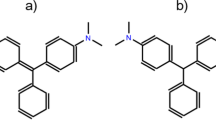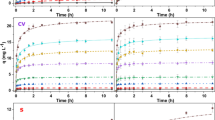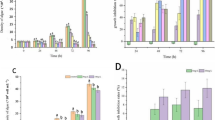Abstract
This paper reports the photochemical degradation of Methylene Blue (MB) in natural seawater (NSW). The photodegradation reaction conformed to the first-order reaction kinetics with the rate constant 0.0158 min-1. MB was photochemically degradated faster under high-pressure mercury lamp (HPML) than under sunlight. When MB was in lower concentrations, salinity could inhibit the photoreaction whereas MB in higher concentration, salinity could accelerate the photoreaction. Humid acid could also inhibit the photoreactions. Toxicity tests with marine phytoplankton Skeletonema costatum (Sk) and Heterosigma akashiwo Hada (Ha) showed decreased acute toxicity after photodegradation.
Similar content being viewed by others
References
Aleboyeh, A., Aleboyeh, H., and Moussa, Y., 2003. Critical effect of hydrogen peroxide in photochemical oxidative decolorization of dyes: Acid Orange 8, Acid Blue 74 and Methyl Orange. Dyes Pigments, 57(1): 67–75.
Augugliaro, V., Baiocchi, C., Bianco-Prevot, A., Garcia-Lopez, E., Loddo, V., Malato, S., et al., 2002. Azo-dyes photocatalytic degradation in aqueous suspension of TiO2 under solar irradiation. Chemosphere, 49(10): 1223–1230.
Banat, I. M., Nigam, P., Singh, D., and Marchant, R., 1996. Microbial decolorization of textile-dye-containing effluents: a review. Bioresour. Technol., 58(3): 217–227.
Chuah, T. G., Jumasiah, A., Azni, I., Katayon, S., and Choong, S. Y., 2005. Rice husk as a potentially low-cost biosorbent for heavy metal and dye removal: an overview. Desalination, 175(3): 305–316.
Flora, S. D., B’agnasco, M. and Zanacchi, P., 1991. Genotoxic, carcinogenic, and teratogenic hazards in the marine environment, with special reference to the Mediterranean Sea. Mutat. Res./Rev. Genet. Toxicol., 258(3): 285–320.
Fu, Y., and Viraraghavan, T., 2001. Fungal decolourization of wastewaters: a review. Bioresour. Technol., 79(3): 251–262.
Guillard R. R. L., 1975. Culture of phytoplankton for feeding marine invertebrates. In: Culture of Marine Invertebrate Animals. Plenum Press, New York, 29–60.
Gutierrez, M. I., Luiz, M., and García, N. A., 1995. Modelling the photochemical fate of organic compounds in seawater: a study on singlet molecular oxygen-mediated reactions. Mar. Pollut. Bull., 30(8): 555–557.
Islam, Md. S., and Tanaka, M., 2004. Impacts of pollution on coastal and marine ecosystems including coastal and marine fisheries and approach for management: a review and synthesis. Mar. Pollut. Bull., 48(7–8): 624–649.
Juang R. S., Tseng, R. L., Wu, F. C., and Lee, S. H., 1997. Adsorption behaviour of reactive dyes from aqueous solutions on chitosan. J. Chem. Technol. Biotechnol., 70(4): 391–399.
Konstantinou, I. K., and Albanis, T. A., 2003. Photocatalytic transformation of pesticides in aqueous titanium dioxide suspensions using artificial and solar light: intermediates and degradation pathways. Appl. Catal. B: Environ., 42(4): 319–335.
Makita M, and Harata A., 2008. Photocatalytic decolorization of rhodamine B dye as a model of dissolved organic compounds: Influence of dissolved inorganic chloride salts in seawater of the Sea of Japan. Chem. Eng. Process: Process Intensifi., 47(5): 859–863.
Mishra, G., and Tripathy, M., 1993. A critical review of the treatment for decolourization of textile effluent. Colourage, 40(10): 35–38.
Nelson, N. B., Siegel, D. A., and Michaels, A. F., 1998. Seasonal dynamics of colored dissolved material in the Sargasso Sea. Deep Sea Res., 45(6): 931–957.
Reeves, P., Ohlhausen, R., Sloan, D., Pamplin K., and Scoggins, T., 1992. Photocatalytic destruction of organic dyes in aqueous TiO2 suspensions using concentrated simulated and natural solar energy. Solar Energy, 48(6): 413–420.
Robinson, T., Mcmullan, G., Marchant, R., and Nigam, P., 2001. Remediation of dyes in textile effluent: a critical review on current treatment technologies with a proposed alternative. Bioresour. Technol., 77(3): 247–255.
Sarasa, J., Roche, M. P., Ormad, M. P., Gimeno, E., Puig, A., and Ovelleiro, J. L., 1998. Treatment of a wastewater resulting from dyes manufacturing with ozone and chemical coagulation. Water Res., 32(9): 2721–2727.
Šepič, E., Bricelj, M., and Leskovšek, H., 2003. Toxicity of fluoranthene and its biodegradation metabolites to aquatic organisms. Chemosphere, 52(1): 1125–1133.
Shu, H., and Chang, M., 2005. Pre-ozonation coupled with UV/H2O2 process for the decolorization and mineralization of cotton dyeing effluent and synthesized C.I. Direct Black 22 wastewater. J. Hazard. Mater., 121(1–3): 127–133.
Slokar, Y. M., and Le Marechal, M. A., 1998. Methods of decoloration of textile wastewaters. Dyes Pigments, 37(4): 335–356.
Sponza, D. T., 2006. Toxicity studies in a chemical dye production industry in Turkey. J. Hazard. Mater., 138(3): 438–447.
Stylidi, M., Kondarides, D. I., and Verykios, X. E., 2003. Pathways of solar light-induced photocatalytic degradation of azo dyes in aqueous TiO2 suspensions. Appl. Catal. B: Environ., 40(4): 271–286.
Tana, I. A.W., Ahmada, A. L., and Hameed, B. H., 2008. Enhancement of basic dye adsorption uptake from aqueous solutions using chemically modified oil palm shell activated carbon. Colloids Surf. A: Physicochem. Eng. Asp., 318(1–3): 88–96.
Wu, C. H., 2004. Comparison of azo dye degradation efficiency using UV/single semiconductor and UV/coupled semiconductor systems. Chemosphere, 57(7): 601–608.
Zhang, T., Oyama, T., Aoshima, A., Hidaka, H., Zhao, J., and Serpone, N., 2001. Photooxidative N-demethylation of methylene blue in aqueous TiO2 dispersions under UV irradiation. J. Photochem. Photobiol. A: Chem., 140(2): 163–172.
Author information
Authors and Affiliations
Corresponding author
Rights and permissions
About this article
Cite this article
Sun, L., Yang, G., Cao, X. et al. Photodegradation of methylene blue in natural seawater. J. Ocean Univ. China 9, 135–138 (2010). https://doi.org/10.1007/s11802-010-0135-4
Received:
Revised:
Accepted:
Published:
Issue Date:
DOI: https://doi.org/10.1007/s11802-010-0135-4




